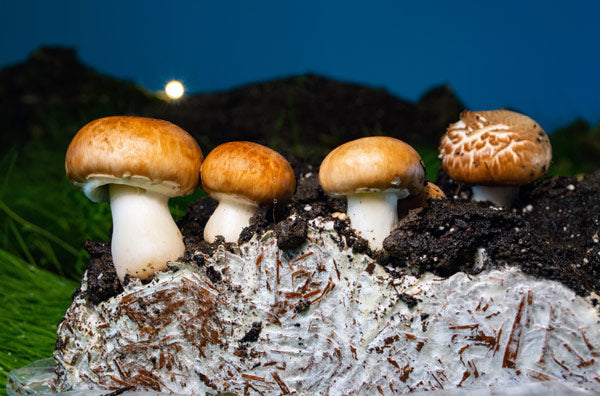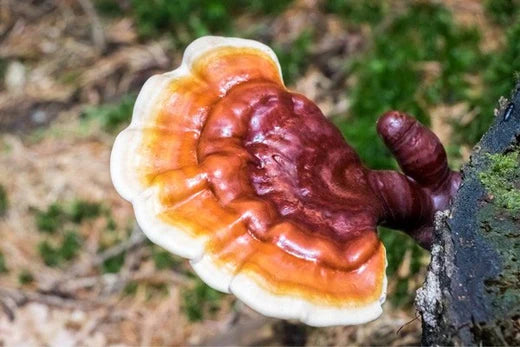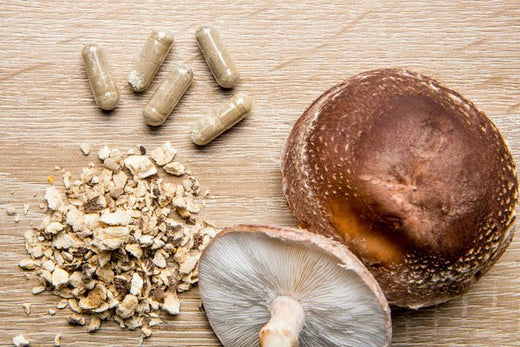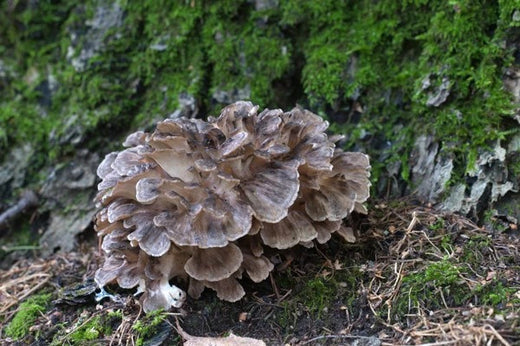Mushroom Lifecycle | An Overview

The kingdom of fungi is an integral and vital component of the Earth's ecosystem, playing a critical role in its health and survival.
Mushrooms are responsible for creating a vast network known as mycelium. It is the root-like structure of a fungal species that spread throughout the Earth's crust, connecting plants, trees, microorganisms, and nutrients. This interconnected underground network fosters symbiotic relationships and boosts the planet's health benefits.
To better comprehend the growth and development of the nutritious mushrooms we consume, it is crucial to learn about their life cycle.
This article aims to provide a comprehensive overview of the life cycle of mushrooms, highlighting every stage of their evolution, from the spore (seeds) to the fruiting body of the mushroom.
Table of Contents
-
Mushroom Lifecycle
-
Defining A Mushroom
-
Phases Explaining a Mushroom’s Lifecycle
-
Spore Dropping
-
Hyphae Formation
-
Mycelium
-
The Hyphal Knot
-
Pinhead to Mushroom
-
Your Questions Answered
-
Where and when does fertilization occur in the mushroom life cycle?
-
At what position in the life cycle does the mushroom perform its function
-
What is the average lifecycle of a mushroom?
-
Summing Up
-
References
Mushroom Lifecycle
The fascinating journey of a mushroom is characterized by five distinct evolutionary phases, from its humble beginnings as a spore or "seed" to its ultimate destination as a fully-formed fruiting body - the recognizable part of the mushroom that we all know and love. This mature body is responsible for releasing new spores, thus kickstarting a fresh cycle of growth and development.
Interestingly, the exact duration of a mushroom's life span can differ from one species to another, with some life cycles lasting anywhere from a mere week to a month or even longer. At the completion of each stage in the life cycle, the process of division and creation of the next generation of the fungal organism commences, perpetuating this incredible cycle of life.
If you're eager to learn more about mushrooms and their life cycle, keep reading to discover further details about each of the five stages that make up this remarkable journey.
Defining A Mushroom
Have you ever wondered what exactly a mushroom is? Contrary to popular belief, mushrooms are not classified as plants nor do they belong to the plant kingdom. In terms of anatomy, they share more similarities with plants, but metabolically speaking, they are actually more closely related to humans than plants. In fact, mushrooms have their own kingdom - the fungi kingdom.
Being a part of the fungi kingdom, mushrooms are heterotrophic organisms. This means that they obtain all their nutrients from other sources such as the environment and soil. When it comes to respiratory function, mushrooms are more similar to humans. Just like us, they take in oxygen and release carbon dioxide, while plants take in carbon dioxide and release oxygen.
Interestingly, mushrooms play a crucial role in our ecosystem as the primary decomposers and recyclers. This helps to improve the immune system of the environment. So, next time you come across a mushroom, remember that it is not just a plant but a unique organism in a classification of its own.

Phases Explaining a Mushroom’s Lifecycle
Spore Dropping
Imagine a mushroom as a new parent, and its spores as its tiny offspring. These spores are the initial stage of a mushroom's life cycle, and they are all genetically identical, making them asexual.
A mushroom's reproductive unit is its spores, which are discharged from the gills and pores located underneath the cap of the mushroom. Countless spores are released into the air every day, innocuously floating around in search of the perfect place to sprout.
When these spores locate the ideal environment with sufficient water and nutrients, they sprout and become hyphae through a process called mycelial expansion or mitosis.
Remarkably, spores contain all the necessary nutrients required for a mature mushroom-fruiting body to grow and reproduce.
Hyphae Formation
When two distinct spores converge, they give rise to hyphae, which serve as the fundamental building block of fungi. These elongated and branched tubular structures harbor both the genetic material and the cytoplasm of mushrooms. Hyphae play a vital role in the absorption of nutrients from the surrounding soil and environment.
Moreover, they transport these nutrients across the entire mushroom, thereby facilitating the mushroom's complete life cycle. Interestingly, hyphae exhibit a sexual dimorphism, and the fusion of hyphae with opposite genders (+ and -) results in the development of mycelium. This mycelium constitutes an interconnected network spanning the Earth's crust.

Mycelium
The fusion of compatible hyphae results in the formation of a fertile and functional network of mycelium cells. These single-celled organisms serve as the backbone of our natural ecosystem and are essential to the mushroom life cycle.
The mycelium network serves as a vital interface between the soil, its microorganisms, the nutrients present within it, and the plants that are connected to it. It is the formation of this network that initiates the growth process, culminating in the emergence of the mushroom fruiting body above the ground.
Over 92% of plant species are linked and interwoven into this mycelial network, making it a crucial component of our agricultural system, which plays a pivotal role in our food production and supply.
The mycelium performs the critical function of providing consistent support for the entire ecosystem. It works to balance the nutrient ratio within the soil, ensuring that all plants and trees in the environment receive optimal nourishment.
Acting as a middleman, the mycelium breaks down its surroundings and absorbs nutrients from the soil, which it then provides to the connected plants. In return, the plants offer glucose to the mycelium and soil, sustaining the symbiotic relationship.
The mycelium contains all the necessary nutrients to complete the mushroom life cycle, transforming from a mycelial network to a hyphal knot - the beginning of what we recognize as a mushroom.
Hyphal Knot
A tiny knot sprouting amidst the damp and fertile earth, the beginning of a young mushroom, also known as a Primordium. This knot will soon evolve into a pinhead, ready to burst from its mycelial phase and mature into a full-grown mushroom. Whether growing in a controlled environment on a mushroom farm or in the wild, this is an exciting phase for growers and mushroom hunters alike, as they witness the emergence of the nascent fruiting body, soon to be a delicious and nutritious addition to any dish.

Pinhead to Mushroom
As a mushroom starts to grow, it goes through various stages, including the development of the hyphal knot and the formation of the pinhead, which eventually matures into a fully grown fruiting body. This is what we usually identify as a mushroom, with its cap and stem, but there's much more to it than meets the eye.
It's important to note that not all pinheads and hyphal knots result in fully matured mushrooms, as external factors like the environment play a crucial role in determining the mushroom's fate.
The fruiting body of a mushroom is a complex structure that includes not just the cap and stem, but also scales and gills. These gills contain a new generation of mushroom spores that are ready to be released and begin the next cycle of the mushroom's life.
Once the mushroom reaches its full size and maturity, it can be harvested and enjoyed. But it's fascinating to think about the intricate process that goes into creating this iconic and delicious fungus.
FAQs
Where and when does fertilization occur in the mushroom life cycle?
The spores of a mushroom are what enable its reproductive process, and fertilization occurs when compatible spores fuse together to form hyphae.
At what position in the life cycle does the mushroom perform its function?
As for the function of the mushroom, it is epitomized by its mycelium network. This complex network allows for the absorption of nutrients and the decomposition of organic matter.
What is the average lifecycle of a mushroom?
But how long does the life cycle of a mushroom last, you might ask? It actually varies from species to species. Some mushrooms can complete their life cycle in just 1-2 days, while others can persist for years, even centuries.

Conclusion
Understanding the life cycle of a mushroom is crucial not only for the cultivation and consumption of these fungi but also for the health and balance of our planet's ecosystems. Starting from asexual spores, the mushroom grows through a series of stages including hyphae, mycelial network, hyphal knot, pinhead, and eventually the recognizable stem and cap of a mature mushroom. The release of new spores marks the beginning of a new life cycle for the fungus.
References
Medicinal Mushrooms: Ancient Remedies Meet Modern Science - https://www.ncbi.nlm.nih.gov/pmc/articles/PMC4684114/
Healing Mushrooms by Tero Isokauppila
Lifespan and functionality of mycorrhizal fungal mycelium are uncoupled from host plant lifespan - https://www.nature.com/articles/s41598-018-28354-5
How Fungi are Constructed - http://website.nbm-mnb.ca/mycologywebpages/NaturalHistoryOfFungi/Thallus.html
Mycelium - https://www.micropia.nl/en/discover/microbiology/mycelium/
The Ecology and Physiology of the Fungal Mycelium: Symposium of the British Mycological Society Held at Bath University 11–15 April 1983
Written by Eliza Hedley
Eliza Hedley is an Australian-born health, mindset and abundance enthusiast obsessed with helping millennials experience living at a higher level.
Eliza's relaxed new-age approach and understanding of nutrition and wellness see her empowering and coaching individuals to understand that their health is the ultimate asset. Upon experiencing firsthand the power and place of tonic herbalism and medicinal mushrooms in everyday life, Eliza’s become an adaptogen fangirl and feels their utilization in today’s world is essential for abundance and wellbeing.
Website: https://theholisticsister.com
Instagram: @the_holistic_sister_






